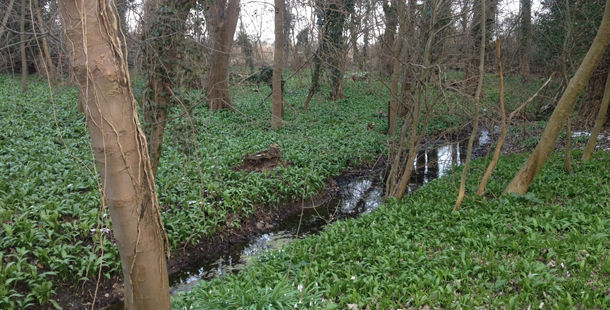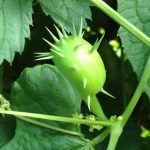What a difference a week makes. Spring is finally here. Yesterday afternoon the wind swung round to the southwest, for what I think, incredibly, is the first time in three months, bringing much warmer air with it and the rain that’s also been lacking. This will get yesterday’s sowings – broad beans, carrots, parsnips and beetroot – off to a good start. I’ll cover the rows with fleece today to keep them that bit warmer. I even left my thermal top and fleece-lined trousers at home for the first time this year (the top probably ought to be retired now).
Needless to say there’s still nothing new to harvest, so I’ll talk instead about another easily foraged wild food. Every day on my way to work I drive through a short stretch of damp deciduous woodland, which in season is carpeted with ramsons, wild garlic. The other common name is Bear’s Garlic. Bears like to grub up the bulbs to eat, apparently, though it’s a while since they’ve done so in Cambridgeshire. The botanical name is Allium ursinum (ursinum means to do with bears: think of the constellation Ursa Major, the Great Bear).
Despite the cold winter, the leaves have been up (and appearing in my meals) since the end of February. These are broad and pointed (lanceolate, lance-shaped, is the botanical term) and appear very bright green against the muted browns of winter leaf-litter. Their kinship with the leaves of leeks and garlic is fairly obvious, though when small they could be confused with Lily of the Valley or Lords-and-Ladies, both of which are poisonous. The easiest test is to bruise a leaf because ramsons really do smell of garlic. When they flower later in the spring it is often their pungent aroma – great garlicky wafts carried on a warm breeze – that first alerts you their presence.
The whole plant is edible, though since it is illegal to dig up wild flowers, if you want to eat the small bulbs I advise buying some plants from a nursery and trying to get them to naturalise in a damp corner of your garden. The most useful part is the leaves, especially when young and tender. Harvesting these in moderation will do stocks no harm. I’ve treated them like chives in salads but they have so many more uses. Try them in a frittata, in the batter for toad-in-the hole, turned into pesto, as a flavouring for olive oil, or just added to soups, stews, stir-fries, stuffing mixes and herb rubs for meat and fish. The flowers are like a white chive and make an attractive garnish and salad ingredient.
Once the trees are in full leaf the ramson show is quickly over and the shaded-out plants die down for another year. From our point of view they have served their purpose admirably, bridging the gap between stored bulb garlic (I have found ‘Solent Wight’ to be the longest keeper but it won’t do a full year) and the first of the new season crop. By May these have usually reached salad onion size and by mid-June have swelled to become full-sized ‘wet’ bulbs, which to my mind is the best-tasting garlic of all.


















